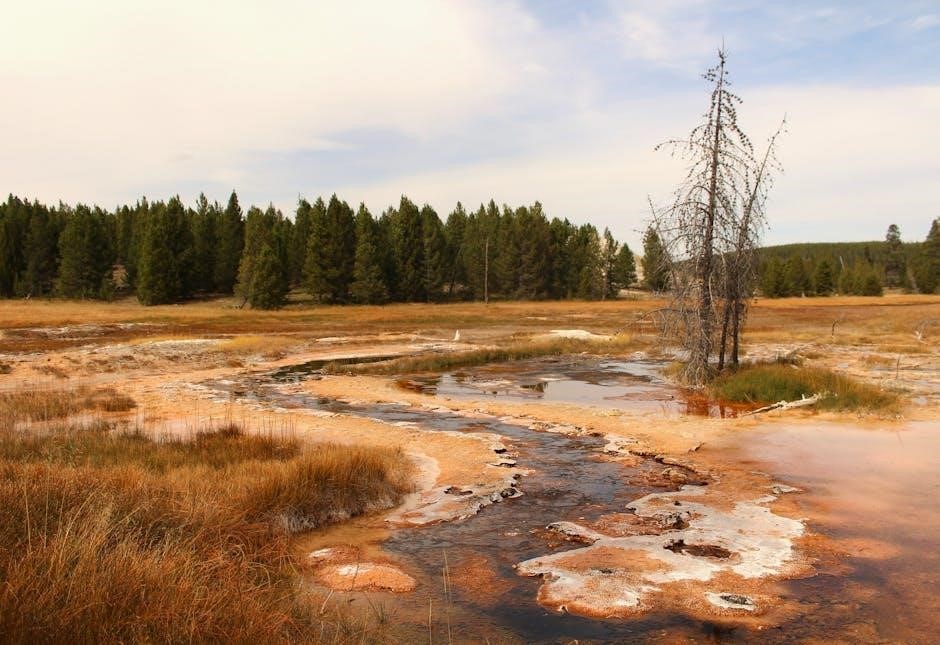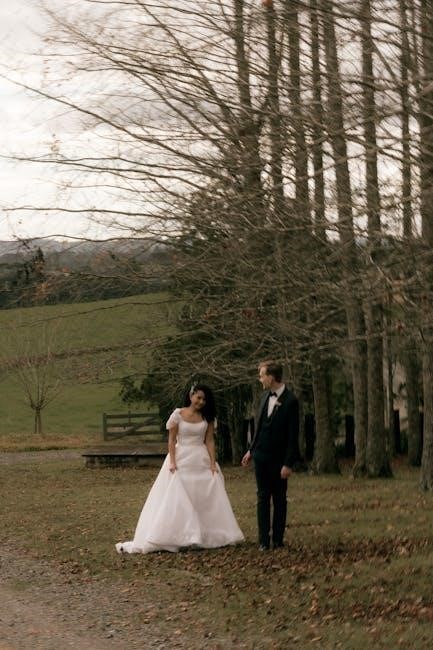Into the Woods is a captivating musical that weaves classic fairy tales into a compelling narrative, exploring themes of wishes, morality, and family ties. The PDF script provides a detailed blueprint for understanding the story, characters, and musical elements, making it an invaluable resource for both study and performance.

Overview of the Musical
Into the Woods is a groundbreaking musical that intertwines beloved fairy tales, such as Cinderella, Little Red Riding Hood, and Jack and the Beanstalk, into a single narrative; The story follows a baker and his wife on a quest to reverse a curse, leading them into the woods, where their paths cross with iconic characters. The PDF script captures the essence of this intricate plot, showcasing Stephen Sondheim’s poignant lyrics and James Lapine’s clever storytelling. It explores themes of wish fulfillment, morality, and the consequences of one’s actions, making it a timeless and thought-provoking production.
Significance of the PDF Version
The PDF version of Into the Woods serves as a vital resource for scholars, performers, and enthusiasts, providing a comprehensive and accessible format for studying the musical. It includes the full script, lyrics, and stage directions, offering insights into the creative vision of Stephen Sondheim and James Lapine. The PDF is widely available online, as seen on platforms like Course Hero, making it easier for educational institutions and theater groups to access and perform the work. Its digital format ensures durability and convenience, preserving the musical’s legacy for future generations while facilitating deeper analysis of its themes, characters, and musical composition.

Historical Background of “Into the Woods”
Into the Woods, created by Stephen Sondheim and James Lapine, premiered in 1987, blending fairy tales with deep moral themes. Its PDF script, widely available online, captures the musical’s enduring legacy, offering insights into its creation and cultural impact.
Premiere and Initial Reception
The musical Into the Woods premiered at the Old Globe Theatre in San Diego in 1987 before opening on Broadway. The production, directed by James Lapine, received widespread acclaim for its innovative storytelling and Sondheim’s haunting melodies. Audiences and critics praised its complex characters and moral ambiguity. The PDF version of the script, widely available online, captures the original dialogue and stage directions, offering insights into the musical’s structure and themes. Its success led to numerous awards, including several Tonys, solidifying its place in musical theater history. The PDF remains a vital resource for scholars and performers studying this timeless work.
James Lapine and Stephen Sondheim Collaboration
The collaboration between James Lapine and Stephen Sondheim on Into the Woods marked a creative synergy that redefined musical theater. Lapine’s masterful storytelling and Sondheim’s lyrical brilliance crafted a narrative that intertwines fairy tales with deep emotional resonance. Their work explored complex themes, blending humor with darker undertones. The PDF script of Into the Woods showcases their collaboration, offering a detailed look at their artistic vision. This partnership not only elevated the musical but also set a new standard for storytelling in theater, leaving a lasting legacy in the world of performing arts and musical compositions. Their combined efforts continue to inspire new adaptations and interpretations.

Literary and Fairy Tale Origins
Into the Woods reimagines classic fairy tales like Cinderella and Little Red Riding Hood, weaving their stories into a unified narrative that explores morality and greed.
Adaptation of Classic Fairy Tales
Stephen Sondheim and James Lapine’s Into the Woods masterfully reimagines beloved fairy tales, blending Cinderella, Little Red Riding Hood, Jack and the Beanstalk, and Rapunzel into a cohesive narrative. The musical adapts these timeless stories by intertwining their plots, creating a fresh exploration of morality, greed, and human nature; While maintaining the essence of the original tales, the adaptation introduces complexity by exploring the consequences of characters’ wishes and actions. This innovative approach challenges traditional happily-ever-after endings, offering a darker, more nuanced perspective. The result is a story that feels both familiar and original, appealing to audiences seeking depth beyond classic fairy tale tropes.
Blending of Multiple Storylines
Into the Woods seamlessly intertwines the narratives of Cinderella, Little Red Riding Hood, Jack and the Beanstalk, and Rapunzel, creating a unified story centered around the Baker and his Wife’s quest to break a family curse. The musical masterfully weaves these classic fairy tales into a single, cohesive plot, where characters’ paths intersect and influence one another. This blending highlights the interconnectedness of human experiences and the unintended consequences of individual desires. By merging these stories, Sondheim and Lapine craft a narrative that explores universal themes of morality, family, and the complexity of wishes, offering a fresh perspective on beloved tales while maintaining their timeless appeal.
Musical Structure and Composition
Into the Woods features complex, layered compositions by Stephen Sondheim, blending recurring motifs, intricate harmonies, and a full orchestral score to reflect the story’s emotional depth and complexity.
Key Songs and Their Roles
The musical Into the Woods features iconic songs that drive the plot and reveal character depth. “Into the Woods” itself serves as a recurring motif, symbolizing adventure and uncertainty. “I Know Things Now” highlights Little Red Riding Hood’s transformation after her encounter with the Wolf. The Baker’s poignant duet “It Takes Two” underscores the challenges and joys of partnership. “No One Is Alone” delivers a powerful moral message, emphasizing shared human experiences. These songs, along with others like “Children Will Listen” and “Stay with Me,” not only advance the story but also explore themes of wishes, consequences, and family bonds, showcasing Sondheim’s masterful blend of melody and meaning.
Orchestration and Musical Style
The orchestration of Into the Woods is notable for its intricate layers and emotional depth, reflecting the complexity of the story. Sondheim’s score often features interwoven melodies, creating a seamless dialogue between characters and themes. The musical style blends traditional fairy tale whimsy with darker, more introspective undertones, achieved through minor keys and dissonant harmonies. A chamber orchestra is typically used, emphasizing clarity and versatility. Instruments like the piano and strings dominate, while woodwinds and brass add texture. This deliberate orchestration enhances the narrative’s emotional resonance, making the music a character in itself. The PDF version preserves this richness, offering detailed insight into Sondheim’s compositional genius.

The Plot of “Into the Woods”
The baker and his wife seek to reverse a curse by gathering magical items in the woods, intertwining with Cinderella, Little Red Riding Hood, and Jack’s tales, exploring wishes’ consequences. The first act resolves their quests, but the second act unveils darker twists, as their happiness unravels, leading to tragedy and reflection on the cost of desires. The narrative seamlessly weaves fairy tale elements with moral complexity, creating a layered story of ambition, loss, and redemption. The PDF version captures this intricate journey, offering a vivid portrayal of the characters’ intertwined fates and emotional struggles. The story’s depth is preserved, ensuring its timeless appeal and universal resonance.
Setting: The Village and the Woods
The story unfolds in a quaint village and the mysterious woods that lie beyond. The village represents order and community, while the woods symbolize chaos, magic, and the unknown. The PDF script vividly describes the setting, with the woods serving as a central location where characters’ fates intertwine. The contrast between the village’s familiarity and the woods’ enchanted yet dangerous atmosphere drives the narrative. The woods are filled with iconic landmarks like Cinderella’s tree and the giant’s beans, emphasizing their magical significance. This dual setting creates a visual and thematic divide, highlighting the journey from comfort to uncertainty and the blending of reality and fantasy.
Key Events and Turning Points
The narrative of Into the Woods is driven by pivotal moments that reshape the characters’ journeys. The PDF script highlights the initial wish-making that propels the story, as the Baker and his Wife seek to break their curse. A turning point occurs when the characters converge in the woods, leading to unexpected encounters and alliances. The arrival of the giant after the beanstalk’s growth introduces chaos, forcing the characters to confront consequences. The death of significant figures and the shattering of illusions mark a dramatic shift, compelling the survivors to reevaluate their priorities and unite against the giant’s wrath. These events underscore the story’s moral complexity and interconnectedness.
Major Characters in “Into the Woods”
The Baker, his wife, Cinderella, Little Red Riding Hood, Jack, and The Witch are central to the story, each representing distinct moral and emotional journeys in the woods.
The Baker and His Wife
The Baker and his Wife are central characters, driven by their desire to have a child, which is thwarted by a witch’s curse. Their journey into the woods symbolizes hope and sacrifice. The Baker, often portrayed as kind but insecure, struggles with moral dilemmas, while his Wife is assertive and determined. Their relationship evolves through challenges, showcasing themes of partnership and growth. The PDF script highlights their emotional depth, as they navigate the consequences of their wishes. Their storyline intertwines with other characters, illustrating the complexity of human motivation and the pursuit of happiness, making them relatable and poignant figures in the narrative.

Cinderella and Her Storyline
Cinderella’s journey in Into the Woods is a poignant exploration of desire, identity, and disillusionment. The PDF script captures her transformation from a oppressed stepdaughter to a princess, yet her happily-ever-after is questioned. Her iconic song, “A Very Nice Prince,” reflects her romantic ideals, while “On the Path” reveals her growing self-awareness. The story subverts traditional fairy tale tropes, showing Cinderella’s struggle with her new reality. Her relationship with her stepmother and stepsisters adds depth, and her ultimate decision to leave the prince underscores themes of self-discovery and the complexity of wishes. Her character becomes a symbol of both aspiration and the reality of choices made.
Other Notable Characters (e.g., Little Red Riding Hood, Jack)
Little Red Riding Hood and Jack are pivotal characters in Into the Woods, each bringing unique dynamics to the story. Little Red Riding Hood’s innocence and naivety are contrasted with her encounter with the Wolf, highlighting themes of deception and growth; Jack, with his bean-selling quest, embodies youthful ambition and the consequences of greed. Both characters’ storylines intersect with the main plot, showcasing how individual desires impact the collective journey. The PDF script details their development, as they navigate moral dilemmas and confront the realities of their wishes. Their roles enrich the narrative, illustrating the complexity of human nature and the unpredictability of fate.

Themes and Moral Lessons
The musical explores the consequences of wishes, moral dilemmas, and family bonds, offering timeless lessons about responsibility and the complexity of human nature and decision-making.
The Cost of Wishes and Greed
Into the Woods examines how wishes, though seemingly fulfilling, often lead to chaos and regret. The woods serve as a metaphor for the darker side of human desire, where characters confront the consequences of their greed. The Baker and his Wife’s quest for a child, Cinderella’s longing for a better life, and Jack’s wish for wealth all unravel into unforeseen challenges. Sondheim’s script highlights the moral lesson that wishes, when driven by selfishness, can destroy the very happiness they aim to achieve. This theme underscores the cautionary tale, reminding audiences to be mindful of the true cost of their desires.
Morality and Consequences
Into the Woods delves deeply into the moral complexities of its characters, exploring how their choices lead to unforeseen consequences. The Witch’s harsh decisions, the Baker’s ethical dilemmas, and Cinderella’s reluctant obedience all highlight the struggle between right and wrong. The musical emphasizes that actions have ripple effects, often harming others and oneself. The Woods, as a symbolic testing ground, force characters to confront their flaws and the repercussions of their decisions. Ultimately, the story serves as a cautionary tale, urging audiences to reflect on the morality of their choices and the responsibility that accompanies them. This theme underscores the musical’s enduring relevance and depth.
Family Ties and Relationships
Into the Woods explores the intricate dynamics of family relationships, showcasing their strength and fragility. The Baker and his Wife’s longing for a child underscores the emotional depth of parenthood, while Cinderella’s strained bond with her stepmother highlights the pain of unresolved conflicts. Jack’s relationship with his overbearing Mother illustrates the challenges of filial loyalty, and Rapunzel’s connection with the Witch reveals the complexities of maternal control. The musical underscores how family ties can both unite and divide, ultimately emphasizing the enduring power of love and forgiveness. These relationships form the emotional core of the story, driving characters toward growth and redemption.
Cultural Impact of “Into the Woods”
Into the Woods revolutionized musical theater with its dark, interwoven fairy tales, captivating global audiences and inspiring countless adaptations, solidifying its timeless cultural influence.
Stage Productions and Adaptations
Into the Woods has been widely performed globally since its 1987 premiere, with numerous stage productions adapting its complex narrative and music. The 2022 Broadway revival became a critical and commercial success, showcasing the musical’s enduring appeal. Adaptations have ranged from intimate theater productions to grand operatic versions, each interpreting the story uniquely. The 2014 Disney film adaptation further expanded its reach, introducing the tale to a broader audience. The availability of the Into the Woods PDF script has facilitated productions worldwide, allowing schools, community theaters, and professional companies to bring this beloved story to life. Its versatility ensures continued relevance in modern theater.
Influence on Modern Musical Theater
Into the Woods has significantly influenced modern musical theater by redefining storytelling and musical composition. Its complex characters, layered themes, and innovative use of fairy tale mash-ups have inspired countless creators. Composers and playwrights often cite Stephen Sondheim’s work as a benchmark for intellectual depth and emotional resonance. The musical’s exploration of moral ambiguity and interconnected narratives has become a blueprint for contemporary shows. The availability of the Into the Woods PDF script has further cemented its impact, allowing educators and artists to study its structure and incorporate similar techniques into new works, ensuring its legacy endures in the evolution of musical theater.
Audience Reception and Popularity
Into the Woods has captivated audiences worldwide with its timeless appeal and emotional depth. The musical’s blend of dark humor, relatable characters, and poignant themes resonates with diverse audiences. Its popularity endures through stage revivals, school productions, and the 2014 film adaptation. The availability of the Into the Woods PDF script has further fueled its accessibility, allowing performers and fans to explore its richness. Fans praise its ability to balance whimsy with profound moral lessons, making it a beloved classic. The musical’s enduring success highlights its universal appeal, ensuring its place as a cornerstone of modern theater and a favorite among audiences of all ages.
“Into the Woods” PDF Version

The Into the Woods PDF provides a comprehensive script, essential for actors, directors, and fans, offering detailed insights into the musical’s storytelling, composition, and analysis.
Contents of the PDF Script
The Into the Woods PDF script includes the full musical text, featuring dialogue, song lyrics, and stage directions. It also contains production notes, character analyses, and insights into the musical’s themes. The script is divided into acts and scenes, making it easy to follow. Additional materials such as cast lists, set design suggestions, and musical annotations are often included. This comprehensive resource is invaluable for actors, directors, and educators, providing a detailed guide to staging the musical. The PDF format ensures accessibility and portability, allowing users to study or perform the work effortlessly. Its completeness makes it an essential tool for understanding and interpreting Into the Woods.
Availability and Usage
The Into the Woods PDF script is widely available for download from official theatrical licensing websites, online retailers, and educational platforms. It is often distributed under specific licensing agreements, ensuring legal use for productions or personal study. The PDF is frequently used by theater groups, schools, and enthusiasts to plan performances or analyze the work. Its digital format allows easy access and sharing among production teams. However, usage may require permission for commercial productions. The script is a vital resource for understanding the musical’s structure and preparing for performances. Its availability has made Into the Woods accessible to a broad audience worldwide.
Importance for Study and Performance
The Into the Woods PDF script is a crucial resource for both academic study and theatrical performance. It provides a detailed blueprint of the musical, including dialogue, stage directions, and song lyrics, making it indispensable for actors, directors, and educators. Students of musical theater can analyze the script to understand character development, plot structure, and thematic elements. For performers, the PDF serves as a primary reference for rehearsals, ensuring consistency and accuracy in interpretations. Its availability enables easy access for classrooms and production teams, fostering a deeper understanding of Sondheim’s masterpiece and its artistic complexity. This makes it a vital tool for both learning and performance.

Analysis of the Script
The Into the Woods PDF script offers a comprehensive analysis of the musical’s narrative structure, character development, and thematic elements, providing insights into Sondheim’s creative process.
Symbolism and Hidden Meanings
The Into the Woods PDF script is rich with symbolism, where the woods represent the unknown, moral dilemmas, and personal growth. The giant symbolizes consequences of unchecked desires, while the witch embodies manipulation and power. The beanstalk and golden egg signify greed and wish fulfillment, tying into the theme of costly wishes. The PDF highlights how characters navigate these symbols, revealing deeper meanings about human nature. The script’s annotations also explore the duality of characters, such as Cinderella’s shift from innocence to self-awareness. These elements create a layered narrative, inviting audiences to interpret the story beyond its surface, making it a timeless allegory for life’s complexities.
Musical Motifs and Their Significance
The Into the Woods PDF script reveals how musical motifs are strategically woven to enhance storytelling and character development. Each character, like Cinderella, has a distinct musical theme that evolves throughout the narrative. The witch’s theme, for instance, carries an air of mystery and power, while the baker’s theme reflects his longing for a child. These motifs are not only melodic but also symbolic, often foreshadowing events or highlighting emotional shifts. The PDF script’s annotations emphasize how Sondheim’s compositions tie characters and plot together, creating a cohesive musical tapestry that deepens the audience’s connection to the story and its themes. This layer of musical storytelling elevates the production beyond traditional theater, making it a masterpiece of modern musical theater.

Critical Reception and Reviews
The Into the Woods PDF script has garnered widespread acclaim for its intricate storytelling and layered themes. Critics praise its ability to blend dark humor with profound moral lessons, making it a standout in musical theater. The PDF version, in particular, has been lauded for its detailed annotations and insights into Sondheim’s compositional genius. Many reviewers highlight how the script’s depth is enhanced by its musical motifs and character development. Fans and scholars alike appreciate the accessibility of the PDF, which has become a vital resource for studying and performing the musical. Its timeless appeal continues to captivate audiences, solidifying its place as a modern classic in theater history.
Legacy and Modern Relevance
Into the Woods remains a timeless masterpiece, blending fairy tales with complex themes. Its narrative structure and music continue to inspire modern theater productions and adaptations, appealing to both longstanding fans and new audiences with its universal themes and emotional depth.
Timeless Appeal of the Story
The timeless appeal of Into the Woods lies in its masterful blend of classic fairy tales with universal themes of desire, morality, and consequence. By intertwining the stories of Cinderella, Little Red Riding Hood, and others, the narrative creates a rich, layered exploration of human nature. Its ability to balance lighthearted humor with dark, emotional depth resonates across generations. The story’s complexity allows audiences to reinterpret its meanings, making it endlessly relevant. The PDF version of the script has further cemented its accessibility, ensuring that this beloved tale continues to captivate readers and inspire new adaptations, solidifying its place as a modern classic.
Contemporary Interpretations
Modern interpretations of Into the Woods often explore its themes through fresh lenses, such as gender roles, social inequality, and environmentalism. Directors and performers frequently reimagine characters like Cinderella or the Witch to reflect contemporary values, adding depth to their motivations. The story’s moral ambiguity resonates in today’s complex world, where audiences grapple with gray areas between right and wrong. The PDF version of the script has enabled easier access for schools and theaters to experiment with innovative stagings, ensuring the tale remains vibrant and thought-provoking. These interpretations highlight the story’s adaptability, keeping it relevant for new generations of audiences and performers alike.
Impact on Future Musicals
Into the Woods has profoundly influenced modern musical theater, inspiring creators to experiment with complex storytelling and moral ambiguity. Its innovative blending of fairy tales and dark themes has set a benchmark for genre-blurring narratives. The musical’s intricate character development and layered lyrics have encouraged writers to craft deeper, more nuanced roles. The PDF version of the script has made it easier for educators and artists to study and adapt its techniques, fostering a new wave of musicals that explore similar themes of human complexity and interconnectedness. This legacy ensures that Into the Woods remains a pivotal work in shaping the future of musical theater.

